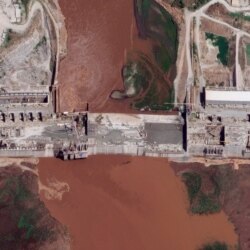After Ethiopia acknowledged this week it has begun to fill the reservoir at its massive dam on the Blue Nile River, observers worry that neighboring countries may feel they are running out of options to respond to a long-planned energy project that could endanger their access to fresh water.
Mirette Mabrouk, a senior fellow and director of the Middle East Institute’s Egypt Studies Program, told VOA that news about the Grand Ethiopian Renaissance Dam (GERD) being filled could ratchet up tensions between Egypt, Sudan and Ethiopia.
She believes military aggression is “option Z” in a long list of strategic moves, but remains possible.
“Nobody wants that kind of conflict. But I do think that if Egypt and Sudan have their backs up against the wall, it may be a final option,” Mabrouk said. “At least possibly for Egypt, with the understanding that Egypt understands very, very well that any military option is really not going to be in anyone’s favor.”
In mid-July, reports emerged that Ethiopia had begun filling the 70 billion cubic meter dam, which lies along the Blue Nile tributary of the Nile River. The claims were backed by satellite images, which appeared to show the dam filling. Ethiopia had previously attributed the water to seasonal overflow.
On Wednesday, Ethiopian Prime Minister Abiy Ahmed said the dam had reached its first-year target for water.
Press release on the follow-up Extraordinary Meeting of the Bureau of the African Union Assembly on the #GERD. pic.twitter.com/TdhLEnz49l
— Office of the Prime Minister - Ethiopia (@PMEthiopia) July 21, 2020
Ethiopia has said the dam will take up to seven years to fill. The first-year target was 4.9 billion cubic meters, Seleshi Bekele, Ethiopia’s water and energy minister said, speaking to VOA Amharic.
“There is no other option. Ethiopia has its own natural rights. Ethiopia doesn’t ask for water from Egypt. It is Ethiopia’s own water resource, and, [within] its sovereignty," Seleshi said. "Therefore ... [finding] a peaceful solution is for all parties to recognize developmental goals and find a medium where there is effectual development.
"But it is clear that the path forward is not sustainable if one party gets zero and the other full benefits,” he added.
Support from opposition
Internally, Prime Minister Abiy appears to have gained support from some opposition parties.
“We believe that it is a good thing that a certain amount of water has already started filling, and, especially when we look at the issue from the Egyptians’ perspective, their stance appears to be that they wouldn’t want a drop of water to fill," Kejela Merdasa, public relations head of the Oromo Liberation Front, told VOA’s Amharic service. "And so, if you look at it from this perspective, it is a good sign that it is being filled. But even now, there is more work left to be done.”
“The Nile dam is being built not with the intention of harming others, but so that Ethiopians can be self-reliant,” said Mulugeta Abebe, the deputy president of the All-Ethiopia Union Party. “It is great that the dam has reached this level of initial filling despite the environment where there are many internal and external armed groups, and our organization is happy to learn about the development.”
Outside Ethiopia’s borders, the news has angered Sudanese and Egyptian negotiators who believe the 2015 Declaration of Principles signed by the three nations forbids unilateral filling.
‘Nothing has shifted’
Some observers say the new announcement hasn't changed much. “The African leaders meeting on GERD [was] a non-event. Fundamentally, nothing has shifted. To sell it as ‘progress,’ ‘breakthrough’ is utterly misleading, if not dishonest,” Rashid Abdi, a Horn analyst tweeted.
The African leaders meeting on #GERD a non-event. Fundamentally, nothing has shifted.
— Rashid Abdi (@RAbdiCG) July 21, 2020
To sell it as "progress", "breakthrough" is utterly misleading, if not dishonest.
“The situation is ... past a dangerous moment, as Egypt, until now, has wisely not responded to [the] first filling by increasing diplomatic pressure and returning to the U.N. Security Council,” William Davison, the International Crisis Group’s senior analyst for Ethiopia, tweeted.
THREAD
— William Davison (@wdavison10) July 23, 2020
This week’s #GERD development at AU meeting was politically significant, as Egypt and Sudan agreed to keep negotiating despite Ethiopia beginning to fill reservoir without reaching an agreement. SU and EG had opposed that approach.
1/6
Sudan has recorded a drop of 90 million cubic meters per day at its al-Deim station on the Blue Nile since Ethiopia began filling the dam. That could spell trouble for the nation’s access to fresh water.
Sudan is 50% desert and Egypt is 96% desert, Mabrouk said, and both rely heavily on the Nile for fresh water. Egypt, for example, has about 560 cubic meters of water available per person, far less than the 1,000 cubic meters needed to be above the U.N.’s water poverty threshold.
“The amount of water that Egypt gets from the Nile basin annually to date is more or less 55 billion cubic meters. Egypt uses between 80 to 90 billion cubic meters every year. And that difference has got to be made up by clever water use. And it’s mostly reuse of water,” Mabrouk said. “Egypt is very, very conscious of its water use and it’s been working on [it] a long time. It has cut down on water-intensive crops like cotton.”
A quick resolution to the GERD conflict appears unlikely. Ethiopia says it will complete the dam between the year 2022 to 2023, but filling it might continue for a year or two after that, Seleshi told VOA Amharic.
Horn of Africa Service’s Solomon Abate and Meleskachew Amiha contributed to this report.









